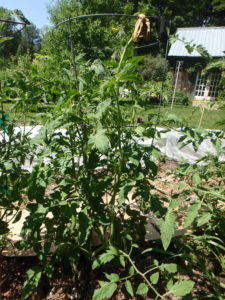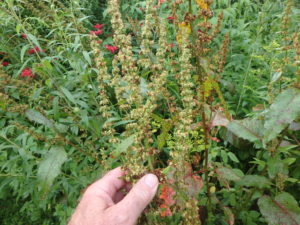Mid-Summer Tasks in the Garden
Oh I how I love the sunny weather we’ve had this summer! It reminds me of the years I spent as a young man working with the Peace Corps in West Africa. There were often 7 or 8 months of sunshine between rainy seasons. And, like there, we need to do some watering if we want to keep our tomatoes happy and healthy.
The best judge of plant water-needs are your eyes. Yes, a finger in the soil will tell a lot, but learning to judge a thirsty plant by the looks of the leaves is an important skill. A thirsty plant has leaves that are dull looking and a little limp. By the time lettuce or leafy greens collapse they are in deep trouble, so pay attention.
I like watering with a watering wand. It is a 30-inch aluminum extension to my hose, with a “rose” or nozzle at the end. By regulating a valve on it you can adjust how much water flows. I walk down the rows of my vegetable garden giving drinks to the tomatoes and lettuce, but not watering the leaves or walkways. Much more efficient than using an overhead sprinkler that waters everything. And it’s very gentle.
It’s not too late to plant seeds. Even if you plant in early August, you have all of August, September and half of October to grow things like lettuce, beans, broccoli and even some annual flowers.
It’s true, for example, that most carrots are 75 days, but some are just 55 to 60. Same for broccoli. Dig out an old seed catalog and look carefully at how many days are needed to reach maturity. We still have at least 75 days of frost-free weather, under normal conditions.
Seeds germinate more quickly now than in the spring because the soil is warm. Just be sure to water every day until they are of a size that can survive a little dryness. Mulching is good to help hold water in the soil.
This year I planted my tomatoes, or most of them, farther apart than I usually do. That, along with the dry weather, has contributed to the nearly disease-free leaves on my tomatoes. Early blight, which turns leaves yellow, brown, then black, has not been much of a problem for me.
If you see tomato leaves yellowing up, cut them off. Open up the bushes by cutting off any branches that are growing in a downward direction, or into the middle of the plant. Those never produce fruit anyway. By cutting them off, you reduce chances of disease spreading and open the middle of the bush to more sunshine. And when a plant gets tall enough, cut off the tips of growing branches to keep it a manageable size- even if it means cutting off a few flower buds.
I contain my tomatoes in cages. I get the 54-inch tall ones, with 4 legs. They are expensive – $7 or $8 each, but worth the money as they last 20 years or so. Of course it’s too late now to cage your plants. But branches of tomatoes laying on the ground are very susceptible to diseases, even if you put down hay for them to lie on.
If your tomatoes are growing out of control and are outside their cages, you have get to work: tie the recalcitrant branches to the outside of the cages. I like strips of old bed sheets, as they are very soft, and much better than twine. I also use green plastic tie-up material sold on rolls. The strips come in half- and three quarter-inch wide rolls.
You can also tie tomato stems to grade stakes. These are hardwood stakes that come as 4-to 6-foot stakes. Push them into your soil, then smack them a few times with a sledge or ordinary hammer. These are good, too, to keep cages from tipping over if you have a heavy load of tomatoes. One word of caution: if you want to work on your tomatoes, only do so when the leaves are dry. Fungal diseases spread more easily when wet.
Many of us get lackadaisical in late summer. August is a hot month, and often humid. Plants are established, and less likely to get elbowed out by weeds, so we don’t always pay attention to weeds. But we should. We never want to let weeds go to seed.
Around the edges of my garden I recently notice lots of 3- to 5-foot tall weeds loaded with seeds. I dug many, using a garden fork to loosen the soil. But when I’m in a hurry, sometimes I just cut off the tall stalks and their seed heads. I always do that with purple loosestrife near my brook, as the roots systems on a mature plant are impossible to pull out. Cutting off the stems helps to prevent the spread of that invasive weed. Don’t put stems with seeds in the compost pile.
On those days when my list of tasks in the garden seems to get longer, not shorter, I like to pause and remember that gardening is supposed to be fun, not a chore. If I don’t get those weeds pulled today, or my tomatoes pruned, I can do it tomorrow. It’s okay to sit in an Adirondack chair and admire the scenery – even if there are chores to do.
Read Henry’s blog posts at https://dailyuv.com/





